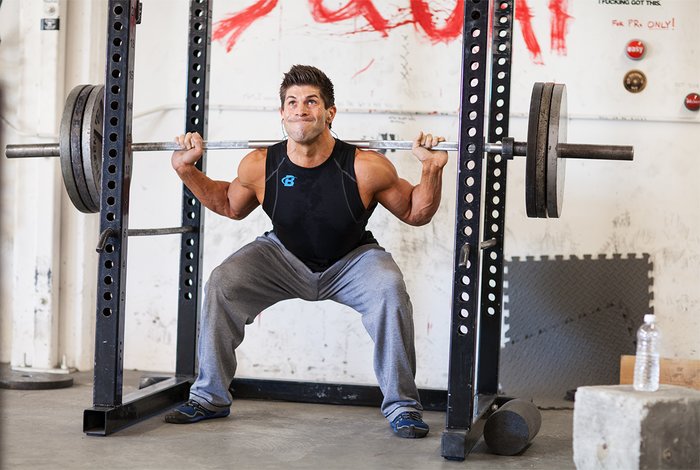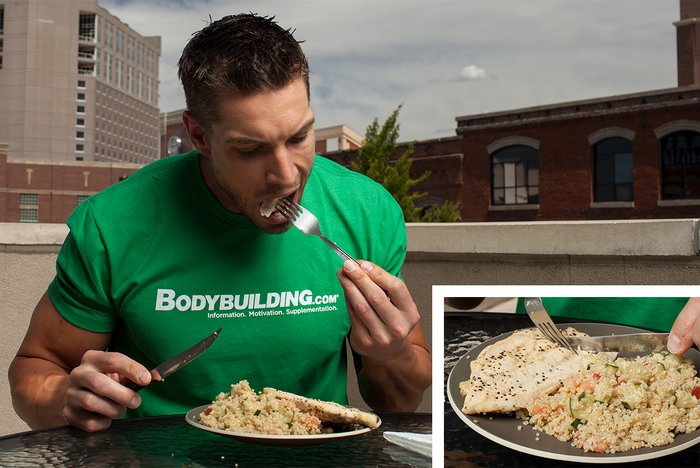Unless you live in South Florida or Hawaii, the end of summer means shorter and colder days approaching. No more beach or pool, no opportunity to display your chiseled bod in a Speedo, and no more reason to suffer through a diet to look good in it.
But the change in season is also a great opportunity for lifters to embark on a new mission, one that's designed to make you stronger! Some call it a "bulk," meaning an extended phase in which you synchronize your training and nutrition with the goals of adding strength and mass.
The focus of your first bulk should be on strength for a couple of reasons. For one thing, elevating your strength means you'll be lifting more weight on every lift two months from now, giving you a better base from which to eventually switch to hypertrophy-focused training. You'll discover that how you approach strength-based training is somewhat different from how you approach gaining muscle.
Second, coupled with a nutrition program designed to add size, you'll accrue noticeable gains in muscle size. Ultimately, you'll need to get strong to get big, so that's where we're starting.
Anyone can get bigger by eating a lot of junk food, but that can have ramifications on what you see in the mirror, your wardrobe, and even your health. So you'll closely monitor what you eat to ensure your gains consist primarily of muscle without commensurate gains in body fat.
Let's identify four important factors as you begin your bulking phase to ensure that, two months from now, you're twice the man you were at the beginning!
1. Set Realistic Expectations
Let's start by hitting the reset button. You've probably heard stories of individuals who made gains in strength in exponential fashion, but those are outliers. An improvement of 15 percent on the main lifts is more realistic for most guys during their first strength phase. While that may not seem considerable, it's the annual year-over-year gains that add up, much like the compounding interest on your 401k.

Gains aren't measured just in pounds on your lifts but pounds on the bathroom scale as well. After all, your goal is bulking. "Individuals in a bulking phase striving to gain 0.5-1.0 percent of their body weight per week will maximize muscle gains as compared to body fat," says Bodybuilding.com nutrition editor Paul Salter, MS, RD. "This amounts to 1-2 pounds per week for a 200-pound individual, or 8-16 pounds over eight weeks.
One additional area that might require a reset is your expectation that you can build strength/muscle and lose body fat at the same time. "You have to be eating a surplus of calories above and beyond what you burn daily to gain weight," says Bodybuilding.com science editor Krissy Kendall, PhD, CSCS. "You'll probably lose some of the rock-hard condition you built up for summer, but don't allow that to weigh on your mind. During a bulk, you can't be half committed."
2. Follow a Well-Designed Offseason Workout Program
It's beyond the scope of this article to provide a singular beginning-level strength-focused workout. Each one must be tailored for your strength levels and schedule. What's more, a great program might even be limited by the availability of the right equipment in your gym. Understand, too, that because of diminishing returns, a solid workout shouldn't be static. It should change over time.
"The act of resistance training doesn't ensure you'll optimize gains in strength and performance," says Kendall. "Rather, it's the systematic structuring of the workouts that determines your results. Periodization, or planned variation in training volume and intensity, is extremely important for continued gains in strength." Following such a program will allow you to make continued gains in strength and hypertrophy above and beyond what you'd achieve if you followed a static routine that doesn't change over time.
You may want to research various programs to find a system that meets your needs and goals, and learn as much as you can about it. A strength-focused training protocol like "Strong in 8 Weeks" is a great place to start.

If you decide to forgo a formal strength-training program and set out on your own, remember these key considerations you'll want to address, because some are very different from how you'd approach a muscle-building workout.
- A focus on strength requires identifying main barbell lifts like the squat, bench press, overhead press, and deadlift, using a full range of motion. Your goal over the course of the program is to improve your strength on these movements.
- Train with loads (called intensity), especially on the first exercises of each workout, and progress week to week from a higher rep target to a lower one.
- Use a lower volume (sets x reps x load) than you would with bodybuilding-style training, because strength training places a greater demand on the nervous system. Between-set rest intervals are also longer (up to about 4 minutes) to ensure CNS recovery, not musculoskeletal recovery.
- Don't train to failure on your exercises; keep 1-2 reps left in the tank. Again, this is not bodybuilding training.
- Practice good form, and rehearse the main lifts so many times they become second nature. The repetition of perfect sets is necessary before you add challenging weights, so if you don't know how to successfully complete your main exercises, start there.
- Determine your one-rep max (1RM) for each of your main lifts, which you can either test directly or approximate. Research shows that you should be able to lift 90 percent of your 1RM for 3-4 reps. So, if you can do 185 pounds for 3 reps, divide 185 by 0.9. Your 1RM is roughly 205 pounds. Knowing your max for each lift allows you to plan your training loads.
- Rely on assistance exercises that are also multijoint in nature to increase your strength on the main exercise. Assistance lifts are most often done for 3 sets of 5-8 reps.
Examples of Main Exercises and Their Accessory Lifts
- Deadlift and its variations: rack pulls, Romanian deadlifts, sumo deadlifts
- Bench press and its variations: incline benches, floor presses, dumbbell bench presses
- Squat and its variations: front squats, box squats, goblet squats
- Overhead press and its variations: seated military presses, dumbbell overhead presses, kettlebell overhead presses
3. Follow a Nutrition Plan Synchronized With Your Training
Whiffing on this component can sink your plans. You can easily shift from a bulking phase to hardgainer status if you're not consuming enough calories, particularly protein, so let's get your bulking nutritional efforts started on the right track.
You can estimate the total daily calories you need to consume with Bodybuilding.com's online calculator. Simply plug in a few pieces of basic information about your size, exercise habits, goals (input "Muscle Gainz" as your goal), and activity level, which then estimates your daily recommended number of calories to support growth and macronutrient recommendations.
Because you're not looking for indiscriminate gains in size (i.e., too much body fat), counting the number of calories you consume can help you avoid going over or under your daily targets. Keeping close track of what you eat for a few weeks will help you better eyeball serving sizes later. Few of us know what a 4-ounce chicken breast looks like compared to a 6-ounce one. Multiply such errors over the course of a day, and you can be wildly off, defeating your efforts.

To optimize muscle-protein synthesis, you don't need to consume more than 25-30 grams of protein at any meal, advises Kendall. She suggests eating multiple meals and snacks throughout the day, perhaps four or more, which also allows you to consume fewer calories at each meal. No one wants to feel like they have to stuff themselves.
Eating clean and healthfully prepared foods while avoiding processed meals, too many cheat foods, and fast-food restaurants can go a long way toward realizing your gains. Opt for complex carbs and starchy carbs over simple ones (except post-workout), and be mindful of saturated fats while limiting trans fats. Do not restrict dietary fat, but choose healthy sources; keep it about 30 percent of total daily calories.
Consuming calories above and beyond what you're used to eating can be difficult for some individuals, even if they're eating additional meals throughout the day. Here's where convenient between-meal muscle-building shakes and go-to fitness snacks can be especially useful.
Nutritional supplements are a great convenience, and many of the best ones—including whey protein, creatine, caffeine, and BCAAs—have established links to muscle and strength gains. These are the ones particularly suited for gaining strength and size.
4. Track Your Progress
Because the online macronutrient calculator only provides estimates, Salter recommends monitoring your results by weighing yourself daily for the first 7-10 days, and then weekly after that. The goal is to hit the benchmark of 0.5-1.0 percent gains in body weight per week so you successfully complete your bulk.
"Gaining weight any faster than this recommendation significantly increases your risk of putting on a substantial amount of body fat," says Salter. "If you're not gaining weight, or gaining too fast, you'll want to fine-tune your daily caloric intake to ensure you're in a moderate daily surplus."
Moreover, you'll want to carefully track your gym sessions by logging your exercises, load, and sets and reps. It's the careful manipulation of training variables that, over time, can help you maximize your gains in strength and size.

It might be tempting at this point to follow up your strength protocol with one designed for explicit muscle building, but Salter has a warning: Following a mass-gain nutrition plan in which you're eating a surplus of calories for too long can create an uptick in body-fat accumulation. He suggests limiting your offseason plan to three months before entering a maintenance phase. At that point, you can return to another bulking phase, in which your training shifts to hypertrophy and a more typical bodybuilding workout.
In the meantime, create a can't-miss offseason strength plan by following the recommendations listed here. And get ready to begin the most dramatic bulk of your life!

